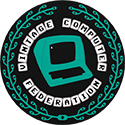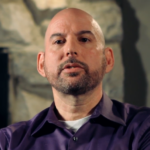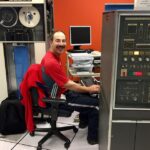Al Alcorn

Allan Alcorn (born January 1, 1948) is an American pioneering engineer and computer scientist best known for creating Pong, one of the first video games.
Alcorn grew up in San Francisco, California, and attended the University of California, Berkeley, graduating with a Bachelor of Science degree in Electrical Engineering and Computer Sciences in 1971.
He worked for the pioneering video company Ampex, where he met Ted Dabney and several other people that would end up being constants through the Atari, Inc., Apple, Cyan Engineering and Pizza Time Theater (now known as Chuck E. Cheese’s) companies.
Alcorn was the designer of the video arcade game Pong, creating it under the direction of Nolan Bushnell and Dabney. Pong was a hit in the 1970s.
In addition to direct involvement with all the breakout Atari products, such as the Atari 2600, Alcorn was involved at some of the historic meetings of Steve Wozniak and Steve Jobs (at that time an Atari employee) presenting their Apple I prototype.
Alcorn was the person who hired Steve Jobs when he applied for a job at Atari in 1974. Jobs had seen a help-wanted ad in the San Jose Mercury newspaper for Atari that said “Have fun, make money.” He showed up in the lobby of the video game manufacturer wearing sandals and disheveled hair, and told the personnel director that he wouldn’t leave until he was given a job.
Greg Berkin

Mr. Berkin earned his computer science degree from the State University of New York at Potsdam and his MBA from Duke University. Greg was nominated as one of the “Top 100 Student Entrepreneurs” by the Association of Collegiate Entrepreneurs (ACE).In the late 1990’s, Berkin was a senior executive with Intel Corporation’s Developer Relations Group (DRG) enabling cutting-edge software applications and tools for the latest Intel-based Pentium computer systems.In addition to his evangelism efforts, Mr. Berkin was named one of the most influential executives for the development of the digital video disc (DVD), working with all of the Hollywood Studios and the consumer electronics industry.
Greg Berkin is also a classic car historian, author and collector, showcasing his work at prestigious Concours events and vintage automotive museums in northern California.
Mr. Berkin is a feature film director and documentary producer as well as a frequent speaker on Apple Computer history, with experience as an authorized Apple dealer sales and business consultant.
Today, Mr. Berkin is a cybersecurity professional serving high net worth clients and fortune 500 companies.
Adrian Black

Adrian has been fixing vintage computers on his Youtube channel “Adrian’s Digital basement” since 2016. His first computer was a Commodore VIC-20 which he got in 1982 at the age of 7. This put him on a lifelong journey of tinkering and working with computers and technology which brings us today, where Adrian can often be found down in his basement making videos about troubleshooting and repairing broken vintage computers. Entirely self taught, Adrian specializes in pinpointing exactly what is wrong with a computer and explaining to his viewers how they can use logical thinking to figure out what has failed on the system. This allows for pinpoint repairs versus randomly replacing parts until the system works again.
Adrian is from Montreal Canada but now resides in Portland Oregon.
Rob Carnegie

Rob Carnegie started his career in Canada near the end of the ‘70s, right in the middle of the mainframe era. As a programmer and later systems analyst he progressed through famous brands like Burroughs, IBM, Honeywell and Wang VS. Rob‘s interest in micro computing goes back that far as well. He was one of the early adopters, purchasing an Apple II in 1979 and an IBM 5155 in 1985. Rob still owns every computer he ever purchased, as well as every magazine, brochure and SWAG item that ever came his way. His collection includes systems as small as the COSMAC Elf to as large as an IBM AS/400. Rob is a founder of the Chilliwack Retro Computing club, which draws members from throughout the greater Vancouver BC area. The club meets monthly in Cowork Chilliwack and attends several special events annually.
Joe Decuir
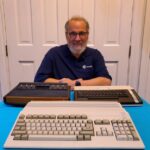
Joe Decuir is cited as an IEEE Fellow, for contributions to personal computer graphics and video games, for his work on three machines at Atari and Amiga. It was fun while it lasted. He will speak about these animation machines, with demonstrations.
Jeri Ellsworth

Jeri Ellsworth is a self-taught computer chip designer, inventor, entrepreneur, product creator, and system-level engineer. Her love for invention began with building race cars before working with hardware design, creating a complete Commodore 64 system on a chip housed within a joystick, called C64 Direct-to-TV. The C64 DTV is a joystick-shaped device that looks like a toy, but contains a complete Commodore 64 computer system with 30 built-in games. Her combined passion for gaming and invention has fueled the creation of many cutting edge technologies, culminating in the creation of Tilt Five®, the world’s first augmented reality tabletop gaming system.
Kate Fox
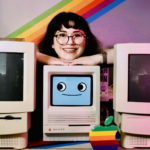
Kate Fox, known to most as “The Macintosh Librarian”, is a YouTube creator interested in the myriad of ways computers and technology have been incorporated into early academics. Together with her trusted sidekick Maccy, the plucky puppet presence who has taken up primary residence inside of a Macintosh SE/30, Ms. Fox explores classic or “retro” computing and edutainment with an eye for how technology is framed for younger users.
Outside of her YouTube work, Kate is an electrical engineer interested in all things electronic and the history thereof. Having grown up with two teachers for parents, she was introduced to computers earlier than most people, and she’s been in love with them ever since.
Maccy, the popular puppet sidekick of the Macintosh Librarian, is a fun loving cartoon character who spends most of his time playing classic edutainment games while living inside of a Macintosh SE/30. Anything from Broderbund or Maxis is a winner in his book. He joins an extended cast of computer puppets that include Twoee, the Apple IIE, and Gessie, the Apple IIGS computers.
Sean Harrington

By day, Sean Harrington serves as Manager of Application Development for the Ventura County Fire Department and as a Professor of Graduate Studies for California Lutheran University’s MSIT program in the evenings. He has designed dozens of enhancements for retro computer and gaming systems, including the Aquarius Composite AV Adapter, the VIC-II Squared video board for C64, and the Aquarius MX (based on Bruce Abbott’s Micro Expander). He is currently working on the MX BASIC 2.0 ROM development team as well as the new Aquarius+ computer with Frank van den Hoef, both due in Summer 2023.
Bil Herd
Carson Holgate
Carson Holgate has a decade of experience solving impossible problems professionally. In her personal life, she prefers to find the intersections between textiles and technology and make them weird.
Ben Jordan
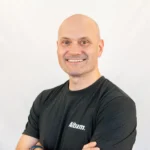
Founder and owner of JordanDSP.com, Ben is a seasoned engineer with a First Class Honors degree in Computer Systems Engineering (embedded hardware) from the University of Southern Queensland. Ben is an IPC-CID+ certified Advanced PCB Designer, and one of the first Altium Certified Trainers in the world, having played an integral role in educating electronics designers and founding the Altium Academy in early 2020.
Dave McMurtrie
Windell Oskay

Windell H. Oskay is the author of The Annotated Build-It-Yourself Science Laboratory and is the cofounder of Evil Mad Scientist Laboratories, where he designs robots for a living. He holds a BA in physics and mathematics from Lake Forest College and a PhD in physics from the University of Texas at Austin. He has been shooting photos since high school and likes cats, except when their hairs become visible on electronic components at high magnification.
Dave Plummer
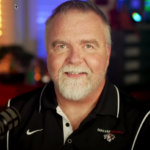
Dave Plummer is a renowned software engineer, celebrated for his significant contributions to Microsoft during the 1990s and early 2000s. He created the Task Manager for Windows, the Space Cadet Pinball ports to Windows NT, Zip file support for Windows, HyperCache for the Amiga and many other software products. He has been issued six patents in the software engineering space and holds the world record score for the video game Tempest. Beyond his career at Microsoft, he continues to share his wealth of knowledge and experiences via his YouTube channel, Dave’s Garage, inspiring future generations of software engineers and tech enthusiasts.
Eric Schlaepfer

Eric Schlaepfer built the MOnSter 6502 (the world’s largest 6502 microprocessor, made out of individual transistors), the Snark Barker (a retro recreation of the famous Sound Blaster sound card), and the Three Fives and XL741 transistor-scale replica chip kits (available from Evil Mad Scientist Laboratories). He also blogs on Twitter (@TubeTimeUS), and Mastodon (mastodon.social/@tubetime), where he posts cross-section photos, shares his retrocomputing and reverse engineering projects, investigates engineering accidents, and even features the occasional vacuum tube or two. His diploma—a BS in electrical engineering from California Polytechnic State University, San Luis Obispo—was signed by Arnold Schwarzenegger.
Ken Shirriff

Ken Shirriff restores old computers, from an Apollo Guidance Computer to a Xerox Alto. He also reverse-engineers 1970s microprocessor dies (currently the 8086), and writes about them at his blog righto.com.
Mike Stewart
Byron Stout
June Tate-Gans
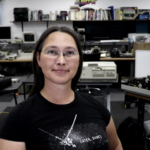
June is a crazy embedded software engineer with a penchant for Commodore 128s that runs the Nybbles and Bytes YouTube channel. She has been hacking in embedded-land for over 8 years professionally for Google, Magic Leap and other companies, but coding since she was 16.
Leonard Tramiel

Tramiel received his bachelor of science degree in physics from Santa Clara University in 1976 and earned his master of arts, master of philosophy, and doctorate of philosophy degrees—all in physics—from Columbia University. He worked in the Columbia Astrophysics Lab under advisor Professor Gary Chanan, now at the University of California at Irvine.
Fresh out of graduate school, Tramiel joined his father and two brothers when his father bought Atari from Warner Communications in 1984. For the next 12 years, Tramiel was involved in the development of Atari’s products as vice president of software, managing an internal group of a dozen programmers while interacting worldwide with software developers and contract programmers.
Since retiring from Atari at age 42, he has been concentrating on advocating science education (See Forbes magazine, Oct. 30, 2000, for his work to improve the quality of science textbooks with the California Department of Education). Tramiel has also been a volunteer eighth-grade astronomy teacher for the past 10 years and has been volunteering at the Chabot Space and Science Center since 2000.
“I think that CFI’s mission of fostering a society based on reason and values is wonderful, in fact vital, for the future of humanity,” Tramiel said.
Marc Verdiell
Hello. I work in a rented lab space under Dr Evil’s volcano, where I build robots and restore pieces of vintage tech assisted by my faithful minions.
Well, I wish. In real life, I am a tech executive in Silicon Valley. I hold a Ph.D. in Opto-Electronics from University of Paris. I am a former Bell Labs researcher, an Intel Fellow and founder of several tech startups in Silicon Valley, all related to high-speed fiber optics communications. I have over 60 U.S. patents and published over 100 refereed research papers.
In 2009, I started building an R2-D2 robot just for fun. Then, in 2015, I became a volunteer at the Computer History Museum in Mountain View, CA, working on the IBM 1401 Restoration Team. At the Museum, I met many like-minded tech historians and restorers (in particular Carl Claunch and Ken Shirriff who appear frequently in my videos), and it all went downhill from there.
My well-equipped basement lab, which was originally dedicated to serious startup development work, is now put to fun use for R2-D2 building, test equipment, and vintage computers restorations. Which is an outlet for my engineering passion, since they don’t let me turn the knobs in the lab at work anymore. Under the pseudonym CuriousMarc, I make videos of these enginerding adventures on YouTube.
As you’ll quickly realize, I concentrate on highly engineered, tour-de-force pieces that represent the best of their time and could not be easily replicated today. The more clever and contrived the better. In my choice of pieces, I also pay attention to the intrinsic beauty of the engineering and design. I want to celebrate engineering so good, it has almost turned into art.
Working on this old stuff forces me to deal with the very fundamentals of electronics (and electro-mechanics). The principles are exactly the same as today, but nothing is hidden in mysterious circuits – you can understand and fix everything. Years of Moore’s law has sure given us gobs of transistors, oceans of memory and a glut of gigacycles, but many times, particularly in consumer hardware, these are simply used to cover up poor and inefficient designs – and resource devouring software. What Intel giveth, Microsoft taketh away, as they say. It often irritates me that my PC takes many seconds to react to a simple command, in which time it has executed many billions of unnecessary instructions and consumed a few gigabytes of memory, no one knowing exactly what for anymore. Nothing like this in old hardware: designs are pure and efficient, and the lack of resources is compensated by engineering mastery and immense cleverness, which is a joy to reverse engineer. Not only does it teach us timeless electrical fundamentals and engineering tricks, but it also gives us a much better appreciation of today’s tech. How did all the technology we take for granted came to be? It will make you a far better engineer and inventor if you take the time to be a thorough student of the inventions of your illustrious predecessors.
Finally, and this is the cherry on the cake, I sometimes have the privilege to meet the very inventors, engineers and entrepreneurs that built these exceptional machines. And then I can actually engage in knowledgeable engineering conversations with them! I have met the inventors of the laser diode, the Xerox Alto, the IBM 1401, the Ethernet, and many of the people that built and programmed the Apollo guidance computer. And that, my friends, is priceless.
Bob Welland

Bob Welland’s career encompasses a wide range of technical domains, including hardware and chip design, operating system kernel design, programming language development, user interface abstractions, scalable server frameworks, and artificial intelligence. His noteworthy contributions to the industry are marked by a number of significant products such as the Commodore Amiga 500, Apple’s Newton, and Microsoft’s Internet Explorer. Although now retired, Welland continues to engage in technological pursuits in his personal lab and machine shop. His leisure time is occupied by family activities, tennis, and expressing his creativity through playing the piano.
